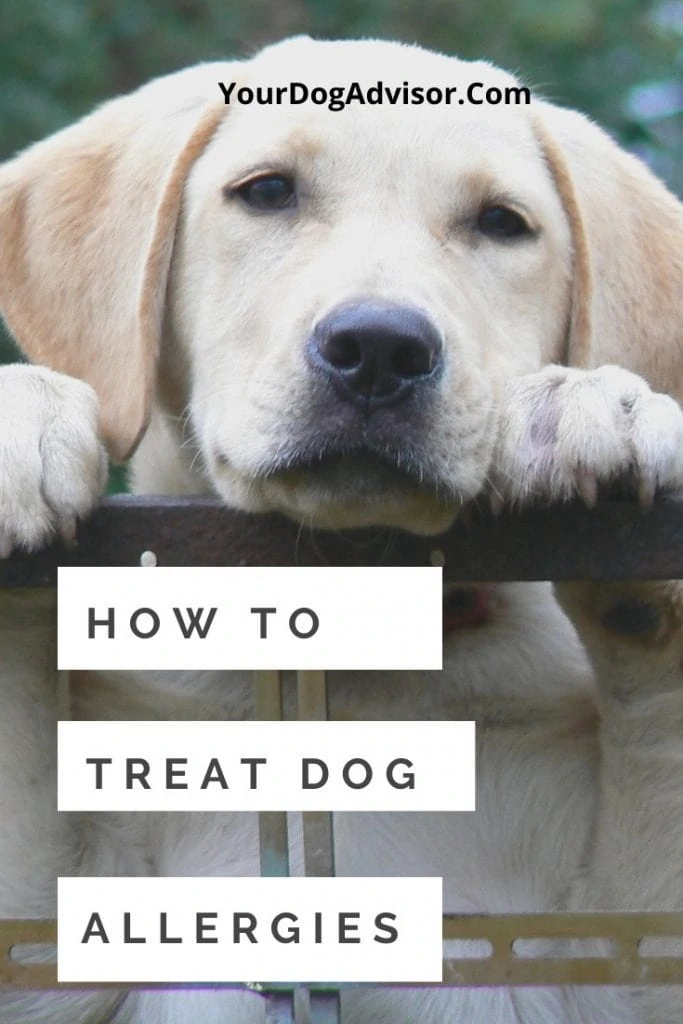
Have you ever noticed your dog obsessively licking or scratching his skin, biting or chewing his paws, or dragging his butt across the carpet or floors as you desperately try to redirect your dinner guests’ attention?
These behaviors are nothing to sneeze at. If your dog has shown any of these symptoms, chances are good that he is suffering from allergies.
Symptoms and triggers of allergies in dogs
Dogs allergy symptoms can present in a variety of ways. Some dogs experience frequent itching and/or sneezing, much like humans do.
Often dogs with allergies that affect the skin scratch and lick repeatedly at areas until they get what are known as “hot spots.” These are patches of the dog’s skin that are moist, warm to the touch, and cause discomfort to your dog.

Skin allergies can become a vicious cycle. Itching can cause scratching, licking and biting which can result in sores or “hot spots” like those pictured above. These cause pain and itching.
Common symptoms of allergies in dogs include:
- Itchy back or base of tail (most commonly flea allergy)
- Itchy ears
- Ear infections
- Coughing
- Constant head shaking
- Vomiting
- Diarrhea
- Paw chewing
- Paw licking
- Swollen paws
- Rash
- Secondary infections of the skin (bacterial or yeast infections)
- Hair loss
- Sneezing
- Scabs
- Hot spots
What triggers an allergic reaction?
The simple answer is: an allergic reaction is triggered by your dog’s exposure to whatever he or she is allergic to.
However, why do certain foods or environmental factors trigger a reaction in one dog and not in another? There are several reasons for this, primarily genetics. Some dogs (or dog breeds) are genetically predisposed to develop allergies.
Consider your last visit to your family doctor. Chances are you had to fill out a form updating your medical history, including your family history of heart disease, cancer, stroke, diabetes, blood pressure, and numerous other medical conditions.
Your doctor uses your family history to determine what health conditions you may be genetically predisposed to develop. This helps you avoid exposure to triggers that could cause you to develop these health problems.
What is my dog allergic to?
Your dog may experience an allergic reaction to any number of things and these allergies may come on at any time in his or her life.

Dogs can be allergic to cigarette smoke.
Common substances dogs may be allergic to include:
- Tree pollen
- Grass pollen
- Mold
- Dust mites
- Dust
- House mites
- Dander
- Cigar or cigarette smoke
- Fleas
- Flea control products
- Cleaning products
- Carpet shampoos (look for items specifically labeled “Pet Friendly”)
- Insecticidal shampoo
- Strong soaps, perfumes, or shampoos
- Plastic food and water dishes
- Pest control products (make sure to tell your exterminator that you have pets)
Main Types of Allergies in Dogs:
Allergies in dogs fall under a few different categories. If you suspect your dog is suffering from an allergic reaction, it likely falls under one of the following:
Atopy – refers to environmental allergies. Like with humans, these allergies occur when your dog is exposed to higher amounts of pollen in the environment. This causes your dog’s body to release more histamine, resulting in uncomfortable symptoms. The majority of allergies affecting dogs fall under this category and get into the dog’s body by inhalation.
Common symptoms of environmental allergies include biting, chewing, licking and scratching.
Flea – Your dog maybe allergic to household fleas or dust mites in his living environment.
Common symptoms include itchy back or base of tail.

Look for carpet cleaners and other household cleaners that are pet-friendly, and less likely to cause an allergic reaction.

This is an enlarged image of a flea, the external parasite that is commonly found on dogs.
Food – Some dogs are allergic to products in their food, requiring a change of diet. This is one reason why choosing a quality diet that meets your dog’s needs is crucial to his health.
The most common allergies are to:
- Beef
- Chicken
- Pork
- Corn
- Wheat; or
- Soy products.
Other common allergens found in food are dairy, egg, lamb, pork, rabbit, and fish.
Common symptoms of a food allergy include itchy skin, chronic ear infections, or gastrointestinal problems like chronic diarrhea, chronic gas and vomiting.
Are some dogs more at risk than others?
Have you ever known someone who was fine with a certain food all through childhood and suddenly developed a severe allergic reaction in adulthood?
Dogs and their humans can develop allergies at anytime during their lives. However, certain dog breeds tend to develop allergies more than others.
The following popular dog breeds commonly suffer from allergic reactions:
- Retrievers – Dr. Amy Haarstad of McKeever Dermatology Clinics in Minnesota said she sees a lot of Labrador Retrievers in her office with allergy symptoms.She did not note one specific cause of allergies in this breed, but said she believed seasonal allergies were the biggest culprit.Another factor contributing to the high number of Labs visiting her practice is the popularity of the breed.
- Standard Poodles – Standard Poodles sometimes have a hereditary skin condition which affects the oil glands. This can cause hair loss and what veterinarian Judy Morgan describes as a “moth-eaten appearance.”
- Setters – The English Setter Association of America notes that English Setters are more likely than many breeds to develop allergies due to a genetic predisposition.
- Pit bull Terriers – Pit bulls and American Staffordshire Terriers often suffer from allergies related to small mites that live in their hair follicles. While some dogs may not show symptoms, others can become very itchy and may develop secondary infections.

Mickey is a Pit bull. Many Pit bulls are mixed breed dogs and they vary in size and coloring. They do share a genetic predisposition to allergies.
- Pugs – Pugs are prone to food and environmental allergies.
- Bulldogs – Bulldogs have short coats and many folds in their skin that can trap allergens and bacteria.
Dogs with short coats, like Shar-Peis and bulldogs, are prone to skin irritation, said Dr. Haarstad. “When the skin folds into itself … then you have the hair on one side poking into the other, …,” she explains.
- English Bulldogs – This breed is more likely to get diseases and secondary (yeast and bacterial) infections in the skin folds. Regular and thorough cleaning is necessary.According to the Merck Veterinary Manual, English Bulldogs are at higher risk for developing a type of skin tumor known as a histiocytoma.
- Boston Terriers – Bostons can have sensitive stomachs and food allergies or intolerance that may cause them to vomit, have diarrhea or gas. Boston Terrier parents will want to talk with their vets about a quality diet for their dog.
- Dobermans – Doberman Pinschers are predisposed to Hypothyroidism. Dogs with this condition might have a sparser coat that appears dry in nature.
The good news is Hypothyroidism is easily treated with synthetic thyroid hormone tablets just as it is in humans.
- Dachshunds – These friendly little “hot dogs” or “wieners,” as they have been called require regular grooming. They are also prone to back problems because of their long bodies and short legs.
- Cocker Spaniels – Spaniels are predisposed to ear and lip fold infections because they have long, heavy ears, said Dr. Judy Morgan DVM, CVA, CVCP, CVFT, world renowned author, speaker, and New Jersey-based holistic veterinarian.
Diagnosing allergies in dogs
If you think your dog suffers from allergies you should visit your vet. He or she will likely want to conduct a complete exam and get a history of your dog’s health and symptoms.
One of the most common causes of allergic reactions in dogs is the same as the most common cause of allergic reactions in their human counterparts; sensitivity to seasonal, environmental allergens.
Your vet can likely diagnose seasonal allergies based on the length of your dog’s symptoms, when symptoms began, and what your dog has been exposed to.
Flea bite or flea infestation allergies are also relatively easy for your vet to diagnose based on physical evidence of fleas.
If after a physical exam and discussion with your veterinarian, he or she is unable to determine the cause of your dog’s symptoms, it is likely your vet will recommend further testing.
Allergy testing for dogs with skin issues usually involves skin and blood testing. Your vet may even recommend a visit with a veterinary dermatologist (skin specialist).
Diagnosing food allergies
The only way to definitively diagnose a food allergy is to feed your dog a prescription diet for a minimum of three to four months until his symptoms are alleviated.
Once his allergic symptoms have cleared up, you and your vet will reintroduce foods back into your dog’s diet in order to determine which foods were causing the allergic reaction.
This is best known as an elimination diet.
Once the food allergy is determined, you have plenty of dietary options for your dog. Some owners opt for homemade diets. If that is not your thing, there are several specialized dog foods on the market now.
An increasing number of dog foods are made specifically for dogs who are allergic to the usual protein sources, and are made with protein sources such as duck, salmon, venison and bison.
Are there allergy medications for dogs?
There are prescription allergy medications for dogs. These are options and may be used in conjunction with other treatments after a thorough review by your vet.
Hydrocortisone (in topical form) is used on dog’s skin to relieve hot spots, itching, and other skin problems.
Atopica, a medication containing cyclosporine, is helpful in treating skin conditions and allergy related itching in some dogs. The drug works by targeting the immune cells that cause the allergic reaction.
Atopica comes in capsule form and does have possible side effects including: upset stomach, vomiting, and diarrhea.
Steroids may be prescribed for short-term treatment of itchy or irritated skin.
Allergy Shots, a treatment known as hyposensitization, may be recommended by your vet if other treatments are not effective. It takes several months before you will see their effectiveness, and allergy shots are not effective in all dogs.
Can I give my dog over-the-counter allergy medication?
Do you find yourself reaching for the Benadryl on those days when your head is stuffed up and your eyes won’t stop watering? Antihistamines can be just as effective for your four-legged friend. You should work with your vet to determine the most effective antihistamine and dosage for your dog.
Benadryl (diphenhydramine), Zyrtec (cetirizine), and Claritin (loratadine) are all commonly used over-the-counter antihistamines that can be given to dogs. They are generally safe when used to relieve allergy symptoms.
However, they may affect some dogs more than others. Some dogs may become drowsy, while others may become hyperactive.
It is important to read the labels of any medication, as some over-the-counter allergy medications contain decongestants which are not safe for dogs.
Talk with your vet and read the labels of any over-the-counter allergy medication before giving it to your pet. For seasonal allergic reactions, Benadryl tends to work best for most breeds.
Natural and at home allergy treatments that work
Prevention
If you know your dog is an allergy sufferer, the best treatment is preventing an allergic reaction before it happens. This means knowing what your dog is allergic to and minimizing exposure.
- Pollen is at its highest in the morning and evening. If your dog is allergic to pollen, keep him inside during those times.
- Keep windows closed when pollen is at its worst to avoid allergens from entering your home.
- Consider putting a shirt and/or booties on your dog when walking him outside during times when pollen is at its worst.
- Consider having your dog exercise on an indoor treadmill during allergy season.This will help prevent the amount of pollen that gets on your dog’s skin.
- Dust can be controlled by frequent vacuuming and dusting, particularly around areas where your dog spends time. Wash his bedding frequently and vacuum around his bed.
- Consider using air conditioners and air purifiers.
Build up your dog’s immune system
One way to strengthen your dog’s immune system is through what you choose to feed him. Talk to your vet about your dog’s diet. Ask if he or she has any dietary recommendations.
Many people are switching their pets to a “raw diet” because it most closely mimics what dogs ate when they were in the wild. However, this is not necessarily a better diet. So if it is not for you, there are plenty of other options.
Read the label on your pet’s food. Some lower quality, commercial dog foods contain artificial coloring and chemicals to preserve the food. Many of these can actually be harmful.
Understanding pet food labels can be tricky at first, but there are resources that break down the information.
Look for a diet that is organic (made only from organic products) and low in carbohydrates. Organic foods are less likely to contain additives. Your dog is also less likely to suffer an allergic reaction to organic products.
Allergies can cause a dog’s coat to look lackluster and can result in Alopecia (hair loss) and bald spots.
Reducing carbohydrates is important since carbs can cause or worsen existing inflammation, and inflammation is already present if the body is trying to fight off allergies, infection, or disease.
Wipe your dog down after walks or playtime outside.
This eliminates environmental allergens from remaining on your dog’s skin and fur. It also prevents them from coming inside the home where your dog will continue to be exposed to them. Keep a pack of grooming wipes by the door.
Establish a regular bathing routine with hypoallergenic shampoo.
Give regular baths with a natural, hypoallergenic, oatmeal shampoo for dogs. This helps reduce the allergens on your pup. If you notice your dog scratching or licking himself, try an over-the-counter anti-itch shampoo.
Read labels and look for shampoos and wipes that contain aloe and oatmeal, both of which tend to be soothing.
Use a medicated spray for skin allergies
Look for a medicated spray that contains Chlorhexidine Gluconate. This can help relieve fungal and bacterial skin infections your pooch may have resulting from allergies.
You can also treat hotspots with a mild antiseptic spray.
Itching/Scratching – remedies to calm itchy skin
Itching and scratching is the most common allergic reaction and it tends to become a vicious cycle. Your dog will lick or scratch at his itchy skin. This results in making it itch more. He will continue to scratch. The result: itchy, painful sores.
Cool Cloth
Cool water can take the itch out of irritated skin. If your dog will tolerate it, run a washcloth under cool water and then squeeze the cool water over his itchy, irritated skin.
Oats are a natural way to eliminate itch
- Grind a handful of oats in a food processor or blender until they are the consistency of flour.
- Add the ground oat powder to a tub of warm water.
- Rub on your dog.
- Leave the mixture on your dog’s skin for 10 minutes.
- Rinse.
Epsom salts naturally promote healing and reduce inflammation.
- Place a washcloth in warm water with Epsom salts.
- Gently apply this to the affected area of your dog’s skin for five to ten minutes.
- Do this two to three times daily.
Omega-3 fatty acids can be used to reduce inflammation.
- Supplements such as Omega-3 Chewable Tablets which are made specifically for dogs can help with inflammation, itching, and seasonal allergies.
Dr. Karen Becker, an integrative pet care expert, recommends salmon oil, krill oil, tuna oil, and anchovy oil as other excellent sources of Omega-3 fatty acids.
How do I know which treatment to choose?
If you are unsure which treatment or treatments to try for your dog’s allergy symptoms, rest assured you are not alone. I’ve faced the same question. My American Staffordshire Terrier, Max, suffers from allergies that have resulted in chronic ear infections.
At times Max’s ears cause him so much pain, I watch helplessly as he vigorously shakes his head, crying out in pain. I have tried everything from switching his food to herbal remedies to prescription medication to various combinations of all of these.
American Staffordshire Terrier Max suffers from allergies that cause his ears to be itchy and painful.
Guidelines to consider
-
Smallest effective dose – While I was switching Max’s diet, he was also on a prescription allergy medication. I opted to reduce the dose of the medication in order to see if the diet change was making a difference.My veterinarian wholeheartedly agreed with me. He gave me some sage advice that I am passing along:
“The goal is always to use the smallest effective dose of any medication.” - Treat the underlying condition – Whatever route you decide to go, whether it be prescription, diet, or holistic in nature, you should first get a proper diagnosis to make sure you are treating the underlying condition.
Without a proper diagnosis, you could spend time and money simply treating symptoms that never address the actual root cause.
One problem with this is allergies become more difficult to treat as dogs get older. What begin as seasonal allergies can turn into chronic, year-round allergies or secondary infections.
Mickey (white) licks his newly-adopted “brother” Dan’s itchy ears for him.
Ideally, you should work with a veterinarian who you feel is comfortable exploring a variety of treatment options, including holistic treatments.
- Ease of administration – The treatment regimen should be relatively easy for the pet-parents to administer.If treatment becomes too difficult to remember or to complete, you are less likely to follow through with the plan.
I will use my own experience as an example:
When I first took Max to the vet for symptoms of ear discomfort, the doctor used a basic syringe to squirt antibiotic ointment in each of Max’s ears. He did not like it, but tolerated it with a minor fit.
I was then sent home with two identical syringes containing the second dose of the same medication. I was to administer this myself one week later.
Some dog parents would have no problem administering the medication. However Max happens to be larger than I am and absolutely unwilling to allow me to get near his ears.
Dan getting his ears cleaned
I tried everything I could including following him into his crate (which I don’t recommend since it is your dog’s “safe place”).
The result was a fearful dog who was exhibiting dog behavior problems including aggression and a frustrated owner. Ultimately, we took a trip back to the vet for the second dose of ointment.
Keep in mind that any treatment regimen that places too much stress on either the pet or the pet-parents is not going to produce a positive outcome.
Your pet is part of your family. Whether you know it or not, your dog provides you with numerous health benefits. It is your responsibility to do the same for him.
Watching your pet suffer, whether it be with stomach upset or persistent itchy skin, is upsetting and can make you feel helpless.
Keep in mind there are many treatments available to help get your dog’s allergies under control. There is no one “right” method of treatment. Alternative treatment methods are not better or worse than conventional medical treatments.
Rather, you should work with your veterinarian to find the best possible combination of holistic and conventional treatments for your dog and his particular condition. Many holistic or alternative treatments can aid in the effectiveness of conventional treatments.
This can reduce or even eliminate the need for stronger drugs with potentially harmful side effects, while building up your dog’s immune system.


















